Introduction
- Inclusive design is the next level of companies’ work.
- Helps to seize wide populations.
- People with various characteristics are affected.
- Improves brands’ image.
- Generates new ideas.
- Promotes sustainability and cooperation.
The adherence to the inclusive design is now considered the next level of companies’ work as it ensures that there is a correct understanding of diversity among users and their current needs (Brown, 2017). In such a way, the given approach emphasizes the fact that there is an essential demand to affect and include as many people as possible for them to be able to use the provided services or benefit from a particular product (Xiao, 2018). It helps to improve the image of the brand and attract new populations that can potentially be transformed into the target audience (Xiao, 2018). At the same time, higher sustainability levels can be achieved by implementing new ideas that are focused on cooperation with communities.
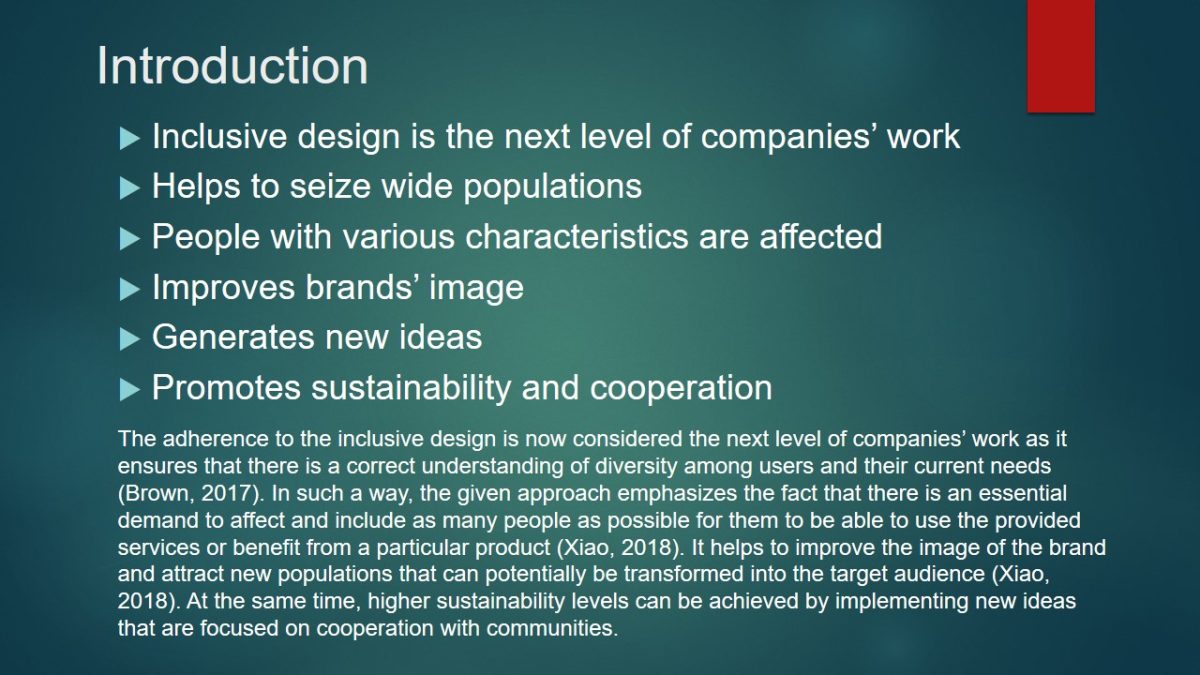
Context
- High speed of globalization.
- Beneficial conditions for tourism business.
- Growth of the target audience.
- Diversification of clients and their needs.
- Appearance of new actors in the market segment.
- Demand for inclusive design and solutions.
The given presentation revolves around the tourism business that becomes extremely topical nowadays. The high speed of globalization contributes to the creation of beneficial conditions for the development of this segment (Inkson & Minnaert, 2018). That is why there is a high level of rivalry. At the same time, new populations with diverse needs become involved, which means that their requirements should be met. Under these conditions, inclusive design becomes one of the best options for tourism business as a way to raise effectiveness and ensure that there will be new ways to improve relations with clients.

Background
- Stable target audience.
- Positive image of the brand.
- Experience in organizing outstanding trips.
- Focus on improved cooperation with clients.
- Diversification of existing tours.
- Attempts to use innovation and new design.
Elder Treks is a global travel agency that has a well-known and recognizable image. It is the first adventure travel company that is designed specially for people 50 and older with the primary aim to meet their specific requirements for rest and recreation (Great reasons, n.d.). It has a broad experience in organizing trips to various parts of the world along with the focus on improved cooperation with clients. At the same time, it tries to find new ways to evolve and create the basis for its further evolution and growth, which is critical regarding the current situation in the market segment.

Problem
- Gradually decreasing income.
- Narrow target audience.
- Increased level of rivalry.
- Absence of innovative solutions.
- Limits for future development.
- Disregard of existing trends.
Nevertheless, at the moment, the company faces several difficulties that significantly reduce its chances for further success. That fact is that the narrow target audience deprives it of the opportunity to involve more clients and generate extra revenue. The company suffers from the absence of inclusive design, which results in the lack of innovative solutions and its gradual decline (Inkson & Minnaert, 2018). Additionally, there is no attention devoted to the local trends presupposing consideration of all categories of customers with diverse needs for recreation and tourism. The given dilemma becomes a core issue that should be addressed to guarantee further growth and ability to win the rivalry peculiar to the sector.
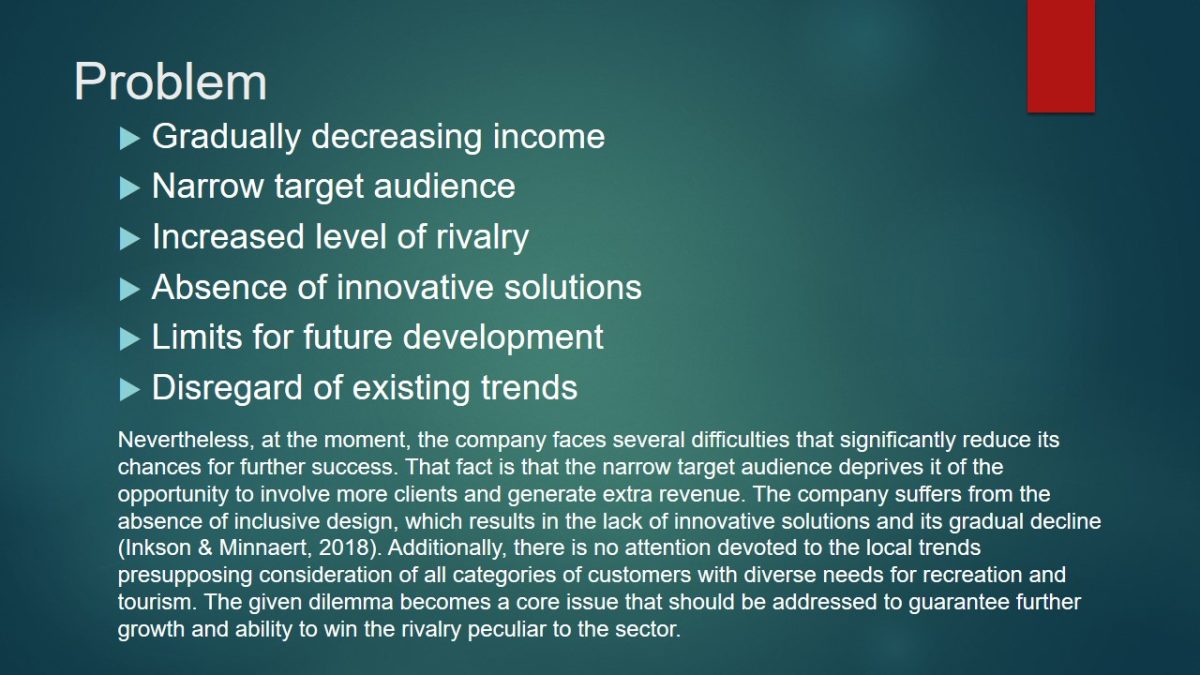
Who is Affected?
- Populations not included in provided programs.
- The whole company.
- Stakeholders, managers, employees.
- Current target groups.
There are several categories affected by the existing problem. First of all, clients who want to acquire outstanding tourist services and know about the brand’s popular image. They cannot find appropriate offerings because of the focus on people 50 and older (Great reasons, n.d.). In such a way, they remain disappointed, and the image of the company suffers. Additionally, stakeholders, managers, and employees might experience a decrease in motivation because of the absence of new projects and the reduction of interest in their products. Finally, the existing categories who use the firm’s services might also be affected by the decreased diversity of offerings and consideration of only a particular age group. It means that the outline issue becomes a serious barrier limiting the further evolution of the travel agency and its future perspectives.

Katherine Jones
- Age – 35.
- Married.
- One child.
- Education – Bachelor of Arts.
- Interests – art, inspiration, landscapes, traveling, tourism, new experiences, new countries, people, hiking, diving.
Being a creative person means to look for inspiration. I that is why I like new challenges, new countries, new roots, and new experiences. I also love traveling with my family, close people, friends. Being physically challenged does not mean you should stay at home! It’s my belief, and I am not ready to give up!
For people such as Katherine Jones, the outlined problem becomes topical. She is 35 years old, and she has some problems with the locomotor system, which means that Katherine might experience some difficulties with usual tours. However, she likes traveling and tourism. That is why inclusive design presupposing effective solutions for people belonging to this category is needed to ensure that there will be the needed cooperation and satisfaction of existing people’s needs.

Solution: Make, Travel, Enjoy!
- Clients can create their own tours!
- Their current unique needs serve as the basis for the journey!
- Consideration of health, age, and social issues!
- Opportunity to join existing groups with similar preferences!
- Accompaniment of specialists if there is a need for it.
- Outstanding experience for all categories of clients!
The new paradigm called Make, Travel, Enjoy (MTE) can be considered a possible solution to the problem. The main idea is to achieve extreme flexibility and variability to create an inclusive design beneficial for the company. Using the provided tour builder, clients of all ages can make their own trip, regarding their current health status, social peculiarities, and other characteristics. Additionally, a specialist can accompany them in case of special needs. If customers want some team – they can join already existing groups to gain a unique experience of cooperation and friendship. It will also help them to socialize.
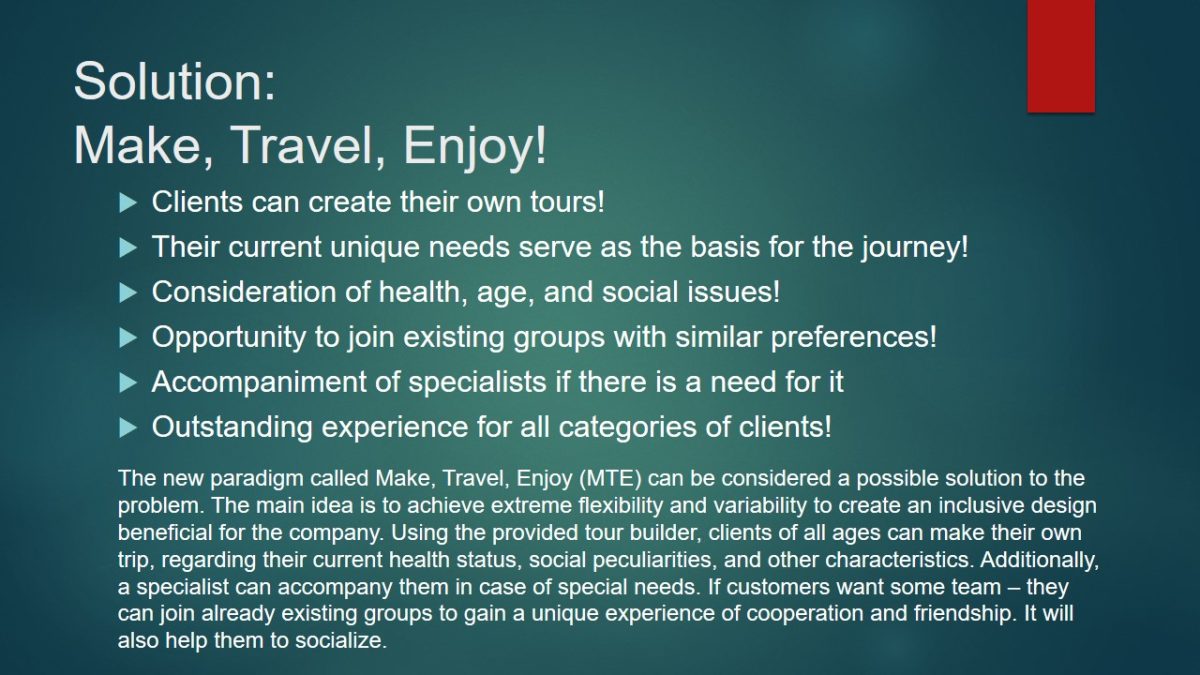
MTE? Sure, its Obvious!
- Inclusion of all categories of clients.
- New opportunities for physically or mentally challenged people.
- Mixed tours for all ages.
- Experience of traveling in groups.
- Increased attention of customers.
- New opportunities for the development.
- Broadening of the target audience.
The major criteria for selecting this solution is its inclusive design. Previously, the company was mainly focused on people older than 50. It seriously limited their abilities for further development as many categories were disregarded. The increased flexibility of tours provides an opportunity to create trips for all individuals regardless of their age. It will help to utilize the inclusive design and generate a competitive advantage by attracting new customers interested by unusual experiences. Additionally, better cooperation with individuals will help to improve the brand’s image.
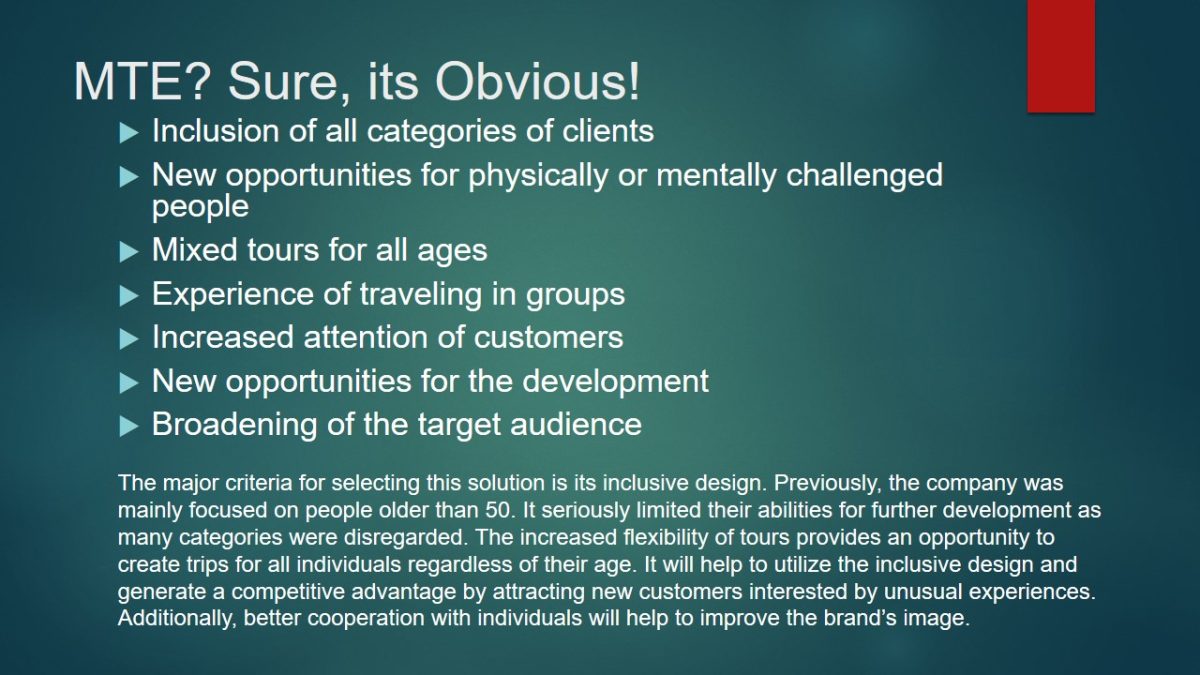
Team
- Human Resources Manager.
- Healthcare specialist.
- Tour designer.
- Economist.
- Instructor.
- Coordinator.
Any team should first of all be effective, which means that there is a need for an HR manager to create the basis for the improved cooperation and task accomplishment. Second, it is important to include a healthcare assistant as offered tours should also be created considering specific customers’ states and their peculiarities (physical challenges); it will help to diversify offered services (Xiao, 2018). A tour designer is needed to help individuals to create the best possible and interesting route to enjoy their time. Second, an instructor should create a guide with a list of things and factors to consider. He/she can also accompany a group. A coordinator might provide assistance to form groups regarding existing interests. Finally, an economist is demanded to outline spending.
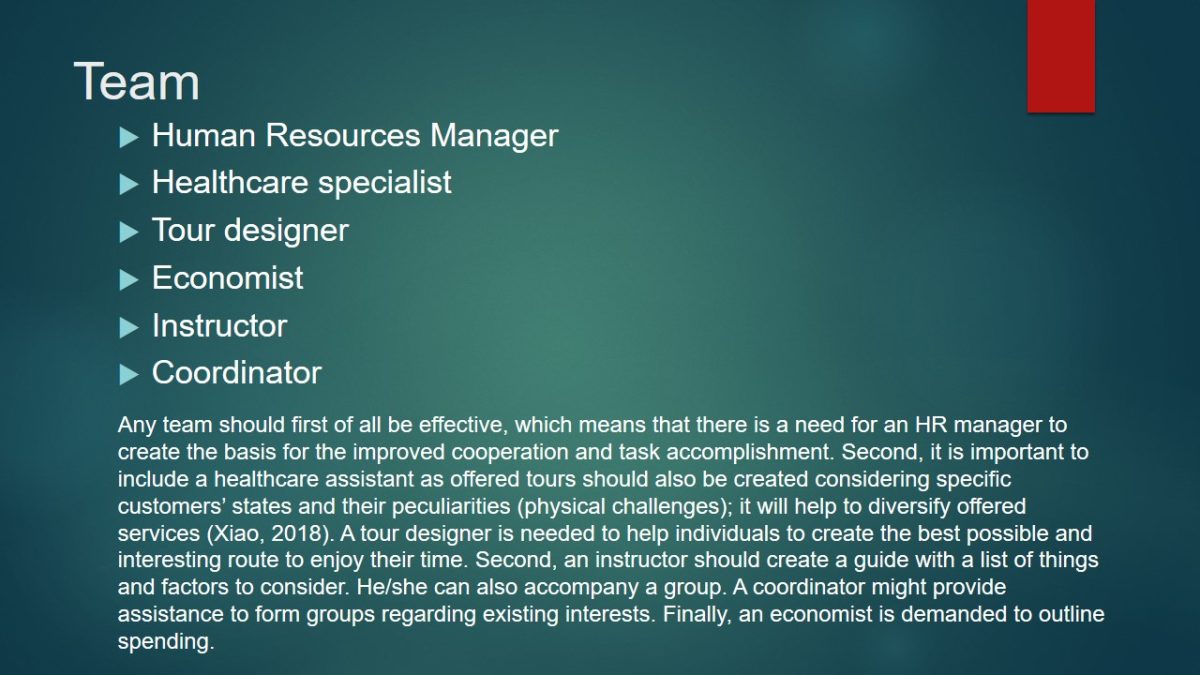
Talents
The ability of any team to cope with emerging tasks to a greater degree depends on talents its members have. First of all, all employees should be skilled in the sphere of tourism or healthcare to ensure that clients and provided with the best possible assistance. Moreover, they should be tolerant and accept diversity to be able to create flexible offerings. Members of a new unit should combine extensive knowledge, experience, and communication skills to guarantee that the main company’s message is conveyed to clients. Finally, innovativeness is also a key to the creation of inclusive design.
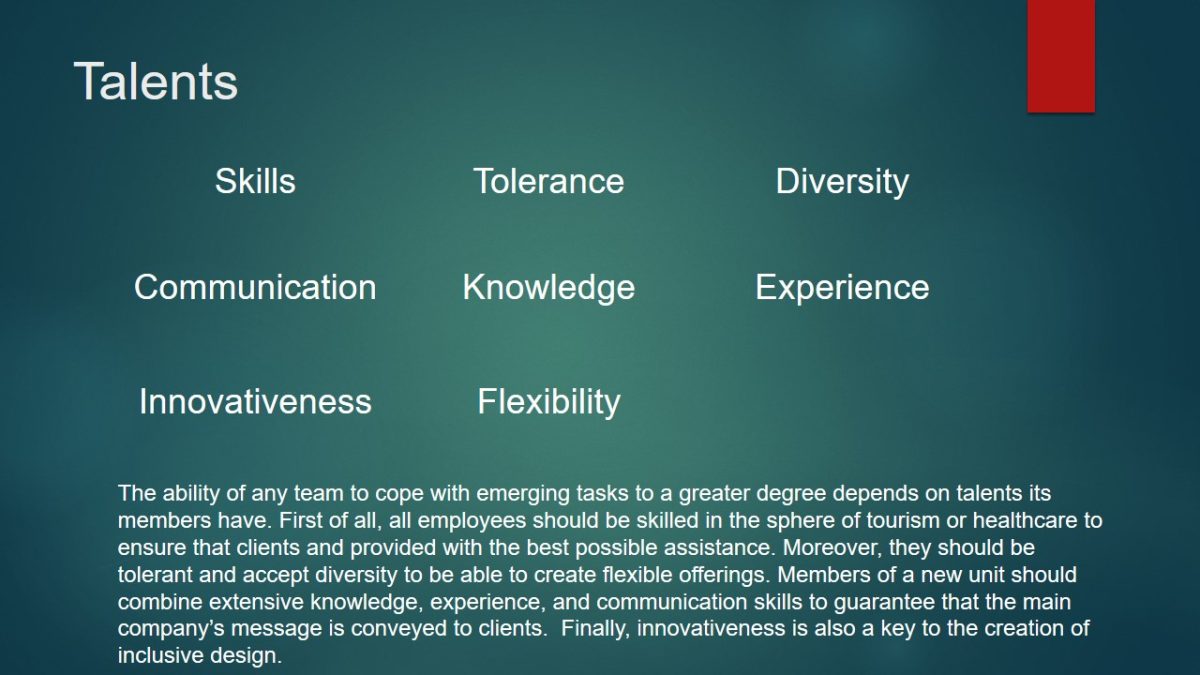
New Department
- A new department, “Tours for Everyone”.
- Increased flexibility.
- Inclusive design.
- Cooperation with clients.
- Involvement of multiple specialists.
- New purposes.
The introduction of the inclusive design presupposes creation of a new department to focus on the achievement of increased flexibility levels and improved cooperation with customers to satisfy their needs. It is critical to ensure that along with the already existing unit working with the old target audience, a new one consisting of specialists mentioned above, will be created. It will contribute to the improved cooperation with all clients and the achievement of new goals such as broadening of the target audience and inclusion of categories previously disregarded by the company (Hedges, 2015). This approach is expected to generate better income and stable revenues, which is critical for the company’s further rise.

Stakeholders
- Employees.
- Clients.
- Founders.
The planned change will affect all aspects of the company’s functioning and result in significant alteration of its activities. For this reason, there are three major groups of stakeholders that will be impacted by this change and benefit from the introduction of the inclusive design. These are employees, clients, and the company’s founders or top management. Accepting the idea that the use of innovative ideas and inclusive design have the positive impact on organizations, it can be expected that the main actors will be satisfied with the achieved outcomes because of the appearance of new opportunities for recreation, new experiences, better salaries, and opportunities for further growth (Quain, 2019). For this reason, the decision to involve more clients can be considered successful.
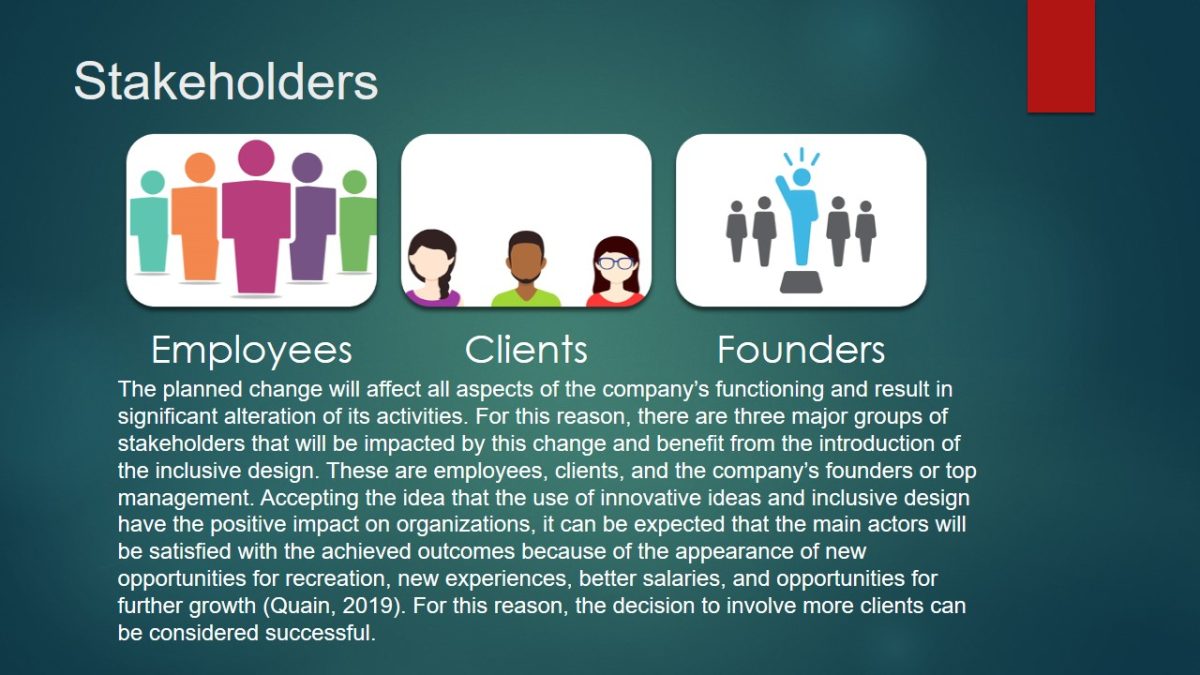
Founders
- Opportunities for growth.
- Better image.
- Cooperation with clients.
- Sustainable development.
- Inclusion.
For founders and owners, the adherence to a new approach will mean the generation of a stable income and benefits. First of all, the broadening of the target audience will mean better opportunities for development and growth, which is critical for any company that aims at holding leading positions. Furthermore, the inclusion of all categories, regardless of their age, health status, and other peculiarities will improve the image of the brand and cooperation with individuals, which is the key for sustainable development and future evolution. For this reason, the planned inclusion will be a positive change contributing to the emergence of new opportunities for owners and top managers to expand and become a global leader in the sphere of tourism.
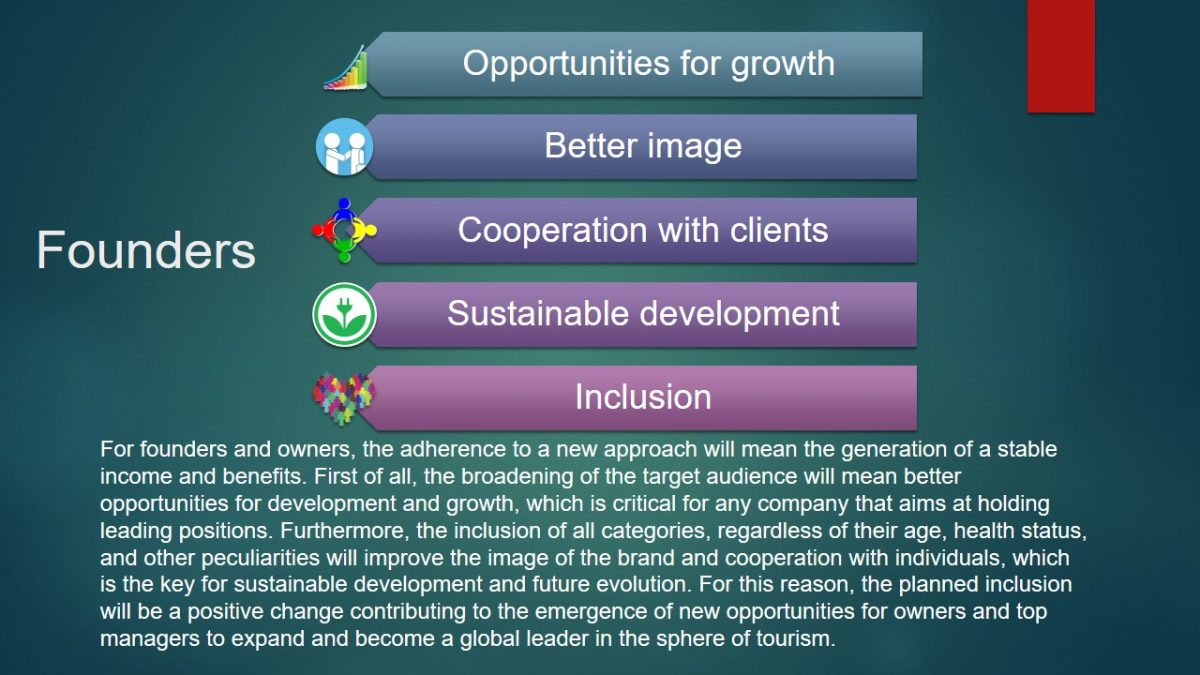
Employees
- New experience.
- Acquisition of communication skills.
- Better work with clients.
- High salaries.
- Opportunities for growth.
It can be expected that for employees, the planned change will also become a good chance to improve their position and satisfy their complex needs. At the moment, they perform traditional tasks and duties that do not contribute to the improvement of their skills. Diversification of the audience will mean the need for better communication skills and improvement in working with clients. It will also be accompanied by the growth of salaries because of the increased complexity of tasks and broadening of the target audience (Newman, Herman, Schwarz, & Nielsen, 2016). In such a way, adherence to the inclusive design can be taken as one of the proven and appropriate methods to achieve better cooperation between colleagues and satisfy their needs for personal and professional evolution.
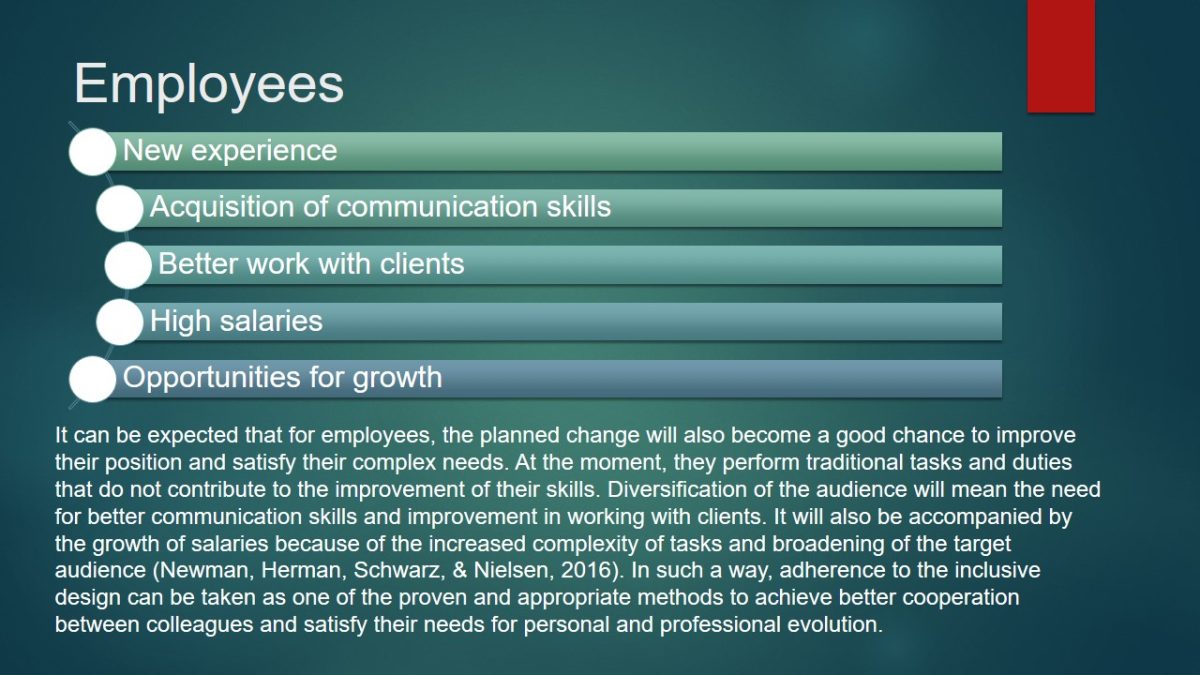
Clients
- New Experiences.
- Better Recreation.
- New Friends.
- Health Improvement.
- Family Rest.
For clients, the introduction of the inclusive design will also mean the appearance of a set of new opportunities that can be used to have better recreation and find new friends. Improved flexibility means that individuals can select tours that are most attractive for them, regardless of their age, social, or health status. Specialists will design trips that promote their health improvement and provide an opportunity for the family vacation, which is extremely important for customers such as Katherine Jones, who has some physical challenges and prefers to travel with her family. From this perspective, the use of inclusive design can be considered one of the effective ways to provide clients with new chances for their outstanding vacation.
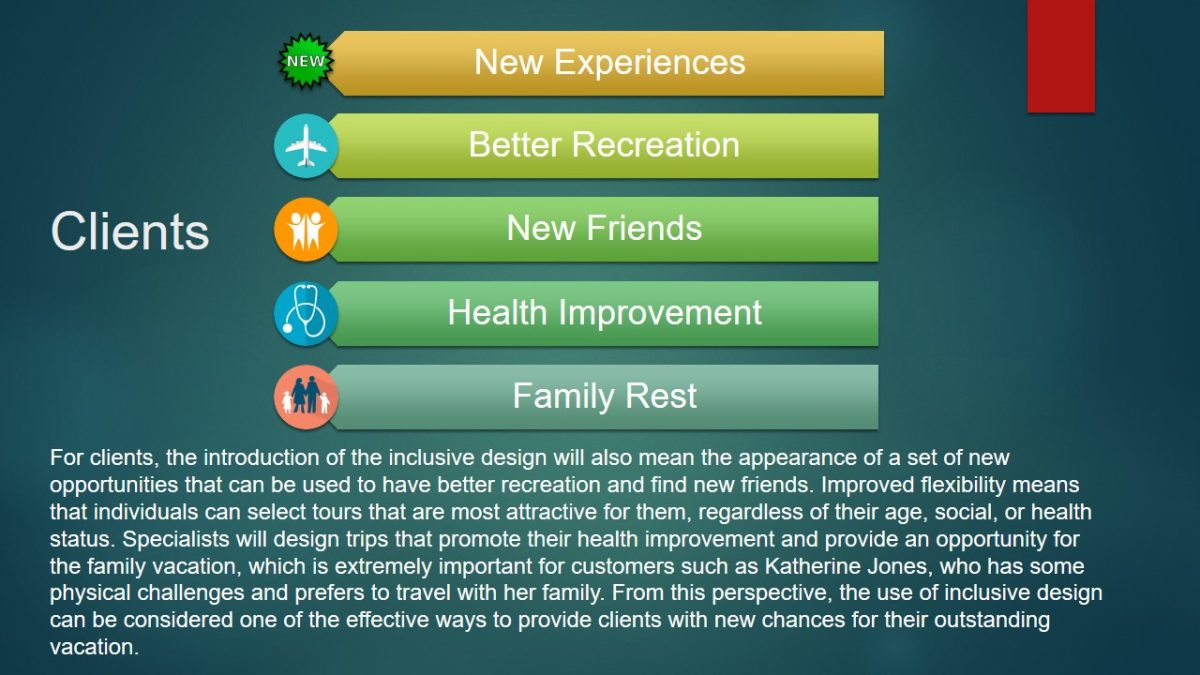
Executive Summary
- MTE project to create inclusive design.
- Diversification of tours.
- Inclusion of clients with various needs.
- Support and provision of advice.
- Broadening of the target audience.
- Sustainable image of the brand.
Summing it up, MTE project can be considered a first step needed for the company to achieve increased sustainability and create an inclusive environment that is needed to attract new customers and guarantee their high levels of satisfaction. For this reason, the diversification of tours with the primary aim to affect new cohorts of clients becomes the central aim of the plan. Additionally, it is critical to assist them in their choices by providing pieces of advice regarding various tours and their ability to meet clients’ diverse requirements. It will become a fundamental project stimulating the sustainable growth of the brand and its becoming among customers globally.
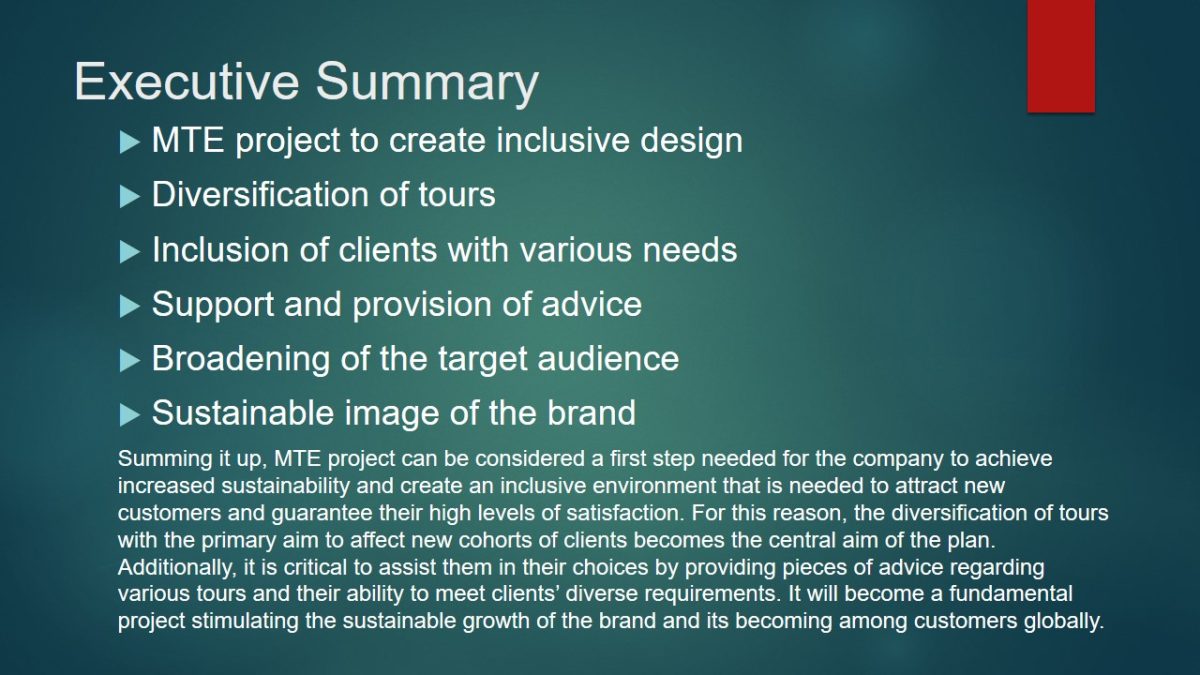
Takeaway 1 Inclusion
- Attracts new clients.
- Improves brand’s image.
- Increases income.
- Provides competitive advantage.
The first takeaway is the importance of inclusion for the functioning of modern companies. The fact is that adherence to this design guarantees the acquisition of new clients vial the diversification of products and introduction of new services that affect populations that were previously disregarded. In such a way, it also helps to improve the image of the brand by demonstrating its readiness to work will all cohorts of customers. It also helps to guarantee a significant increase in income and generation of the competitive advantage that is fundamental for the modern business environment (Perry, 2018). Thus, inclusion remains a critical element of organizations as it helps to consider all existing aspects critical for the development and create a new, more positive environment demanded to achieve success.
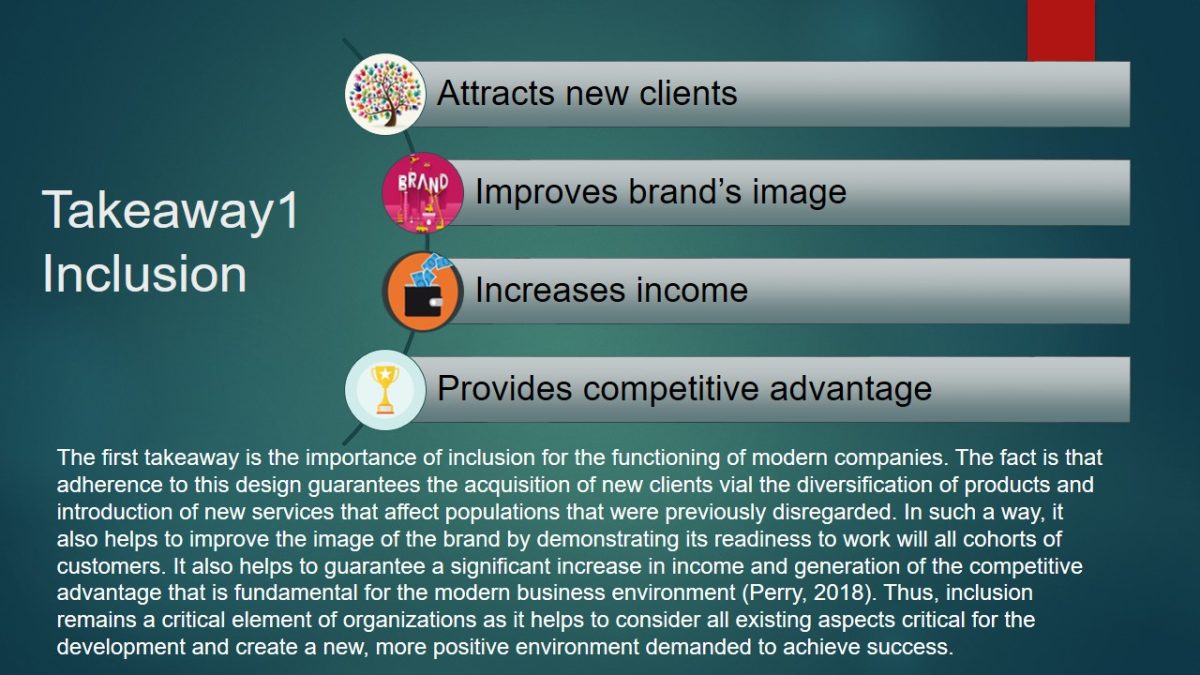
Takeaway 2 Diversity
- Various groups of clients.
- Multiple demands.
- Desire for better cooperation.
- Key to better functioning.
- New opportunities.
The second takeaway is the extreme importance of diversity for the work of modern companies. Being one of the central components of inclusive design, this phenomenon presupposes that there are various groups of customers that have their own unique demands that should be satisfied with the primary goal to ensure that high level of loyalty among the target audience and the emergence of better opportunities for cooperation (Perry, 2018). Consideration of the given factor as one of the central moving forces of the business world will also help to acquire new opportunities for the development and improved functioning in the future. For this reason, it is one of the essential tasks to create a diverse environment.
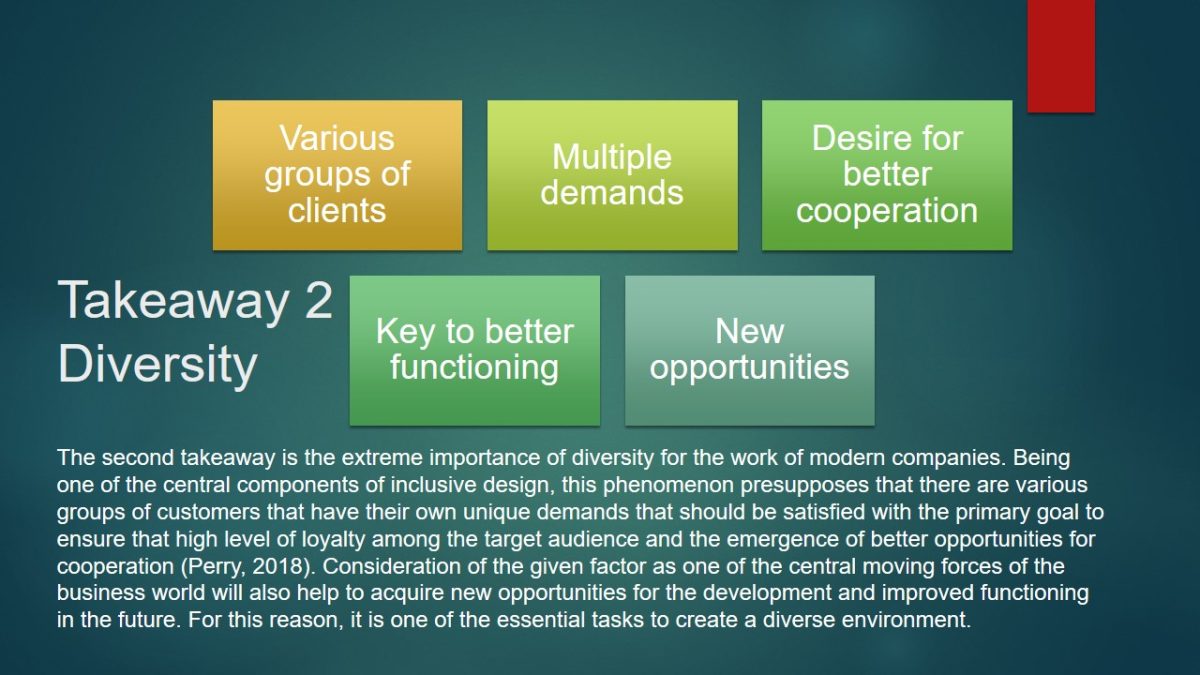
Takeaway 3 Creativity and Flexibility
- Save money.
- Provide opportunities for change.
- Help to evolve.
- Promote a better understanding of clients’ demands.
Finally, one should realize that today creativity and flexibility remain two fundamental aspects of any successful business unit or project. First of all, the utilization of unusual approaches helps to save money, which is crucial regarding the high level of rivalry and the need to struggle with other companies. Additionally, the existence of flexibility helps to introduce changes when it is needed to avoid critical deterioration of the company’s functioning or achieve appropriate results. That is why these two notions become an integral part of the modern business that helps it to evolve and understand clients’ demands better.
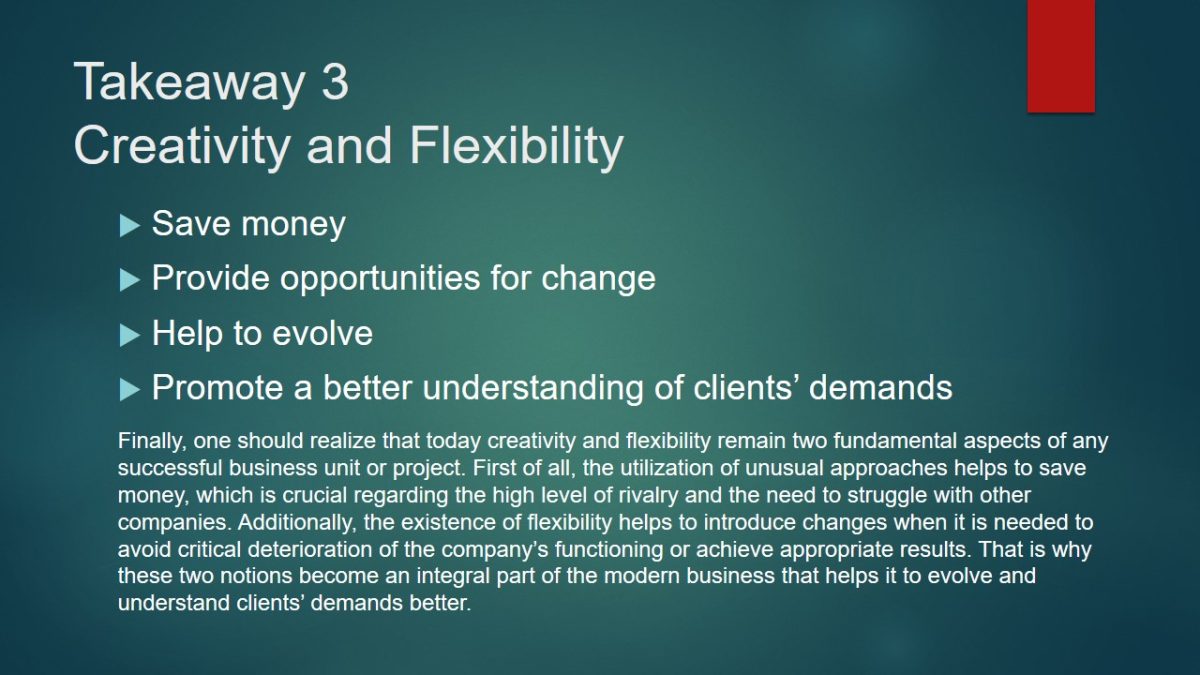
Future strategy
- Organization of a new department.
- Engagement of employees.
- Diversification of tours.
- Cooperation with clients.
- Advertising.
- Monitoring of results.
To achieve the goals topical for the project, it is critical to perform several activities. First, a new department responsible for the creation of new offerings should be organized. It will require new employees, including health workers, and experienced tourist instructors to ensure that all clients are provided with the services they need (Gammal, n.d.). The next step will be the creation of diversified tours via cooperation with clients. The advertising campaign will support this incentive and familiarize clients with the major elements of a new offering. Finally, it is important to monitor results to ensure that there are no flaws or some other negative tendencies.
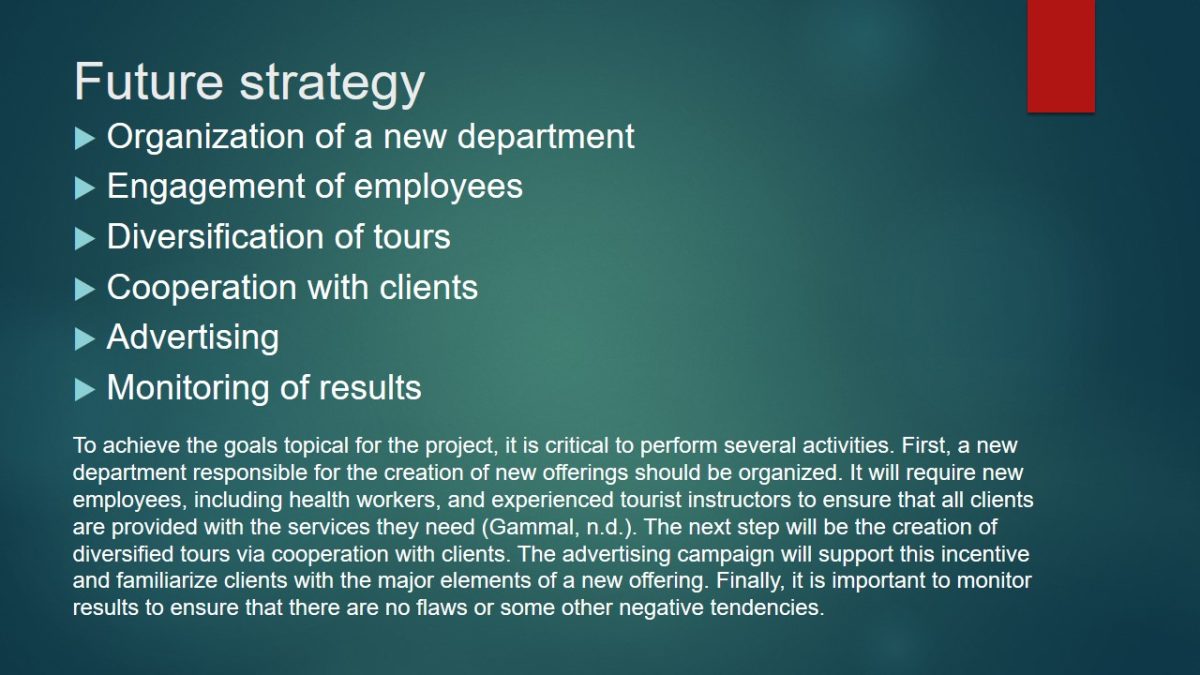
Conclusion
- Critical role of inclusive design.
- Combination of inclusion and innovation.
- Diversity of clients and their needs.
- Use of flexible approaches.
- Creativity.
Altogether, the offered project is focused on the creation of an inclusive environment within the tourist firm that was previously focused on aged individuals. However, the combination of this design with innovative thinking and creativity might help to broaden the target audience by offering diversified tours and trying to consider their unusual preferences or requirements. MTJ will contribute to the introduction of new routes available for wide categories of clients. That is why, using creative methods and flexible offerings, the company might achieve the desired goal and create the basis for its further development and sustainable growth.
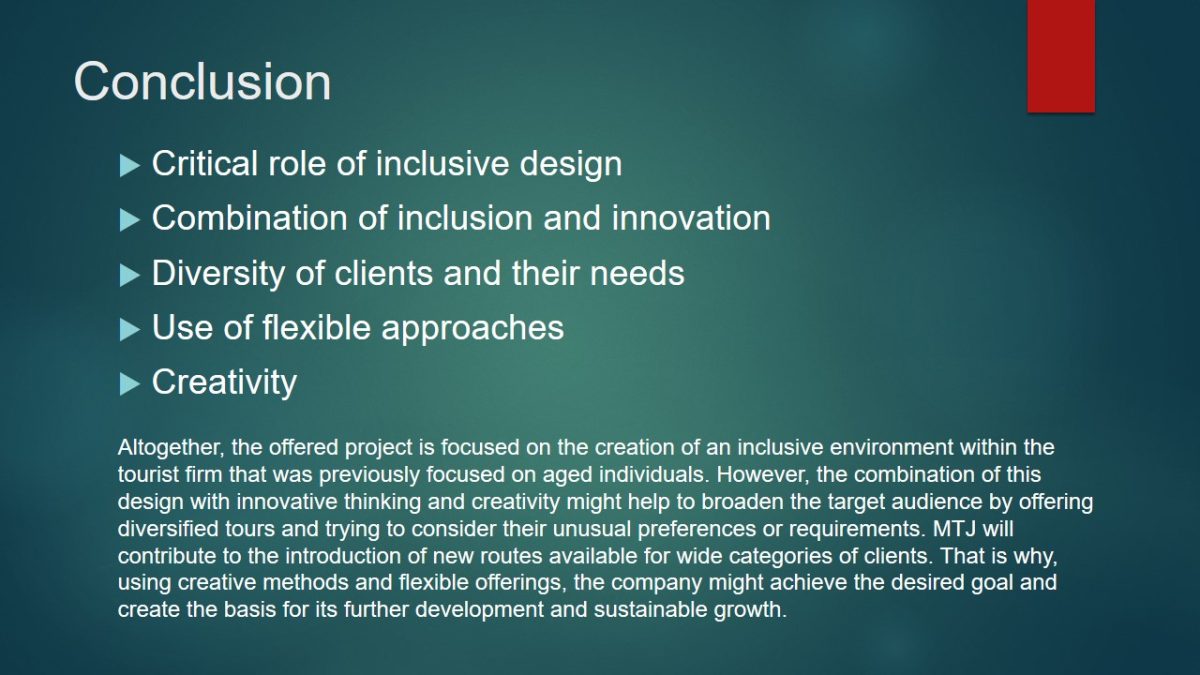
Annotation
Brown (2017) – outlines the correlation between diversity and positive change that is needed to improve the atmosphere and achieve better outcomes.
Gammal, (n.d) – explains how to implement the creative idea into the work of the company and what obstacles might emerge during this process.
Great reasons to travel with ElderTreks (n.d) – provides basic information about the company selected for the analysis and peculiarities of its functioning.
Hedges (2015) – outlines the importance of buy-in for any idea and how it can impact the further success of organizations using new approaches.
Inkson & Minnaert (2018) – offers the basics of tourism management, peculiarities of the affected populations, their demands, and current trends.
Newman, Herman, Schwarz, & Nielsen (2016) – explains the effect entrepreneurial and transformational leadership have on organizations and how creative self-efficacy can be achieved.
Perry (2018) – a guide for the creation of an inclusive organization that considers all existing trends and peculiarities of the market.
Quain (2019) – a detailed explanation of how main barriers that appear during the change process can be overcome.
Xiao (2018) – emphasizes the importance of inclusive design and the central principles that should be followed to create a flexible company.
References
Brown, J. (2017). Inclusion: Diversity, the new workplace & the will to change. Hartford, CT: Publish Your Purpose Press.
Gammal, J. (n.d.). Incubation: Bridging the gap between idea and implementation. Web.
Great reasons to travel with ElderTreks. (n.d.). Web.
Hedges, K. (2015). How to get real buy-in for your idea. Forbes. Web.
Inkson, C., & Minnaert, L. (2018). Tourism management: An introduction (2nd ed.). Boca Raton, FL: SAGE Publications Ltd.
Newman, A., Herman, H., Schwarz, G., & Nielsen, I. (2016). The effects of employees’ creative self-efficacy on innovative behavior. Journal of Business Research, 89, 1-9. Web.
Perry, R. (2018). Belonging at work: Everyday actions you can take to cultivate an inclusive organization. Portland, OR: Bowker Identifier Services.
Quain, S. (2019). Barriers & challenges to change implementation. Chron. Web.
Xiao, L. (2018). 6 principles for inclusive design. UX Planet. Web.